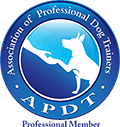Archive CF :: Demythacizing Pup Psychology
Today's pup culture surrounding dog behavior is steeped in myths that are doing anything but promoting greater understanding between our two species. Instead, we distrust and demonize the motivations of our dogs as they jump on us, pull us down the street, rush through the door ahead of us, and curl up comfortably on the couch. It's time to demystify the myths so that we can reestablish trust with our furry best friends.
The Guarding Myth
| Some dogs growl, even bite, when people approach their special person. Chihuahuas are notorious for guarding the lap of their loved one like it was their throne. While it may seem flattering that a dog jealously spurns the contact of others, think of this in the context of the dog guarding his person as he might a desired bone, toy, or location and it seems quite a bit less gallant. |

|
The coveted human must communicate to the dog that access to her is not the dog's to grant or deny. By extracting herself from the dog's company, the human is showing very palpably that she is not the dog's to give. To do this safely, start with the dog on-leash with the leash tethered to something stable. Have someone approach the coveted person with the dog on her lap. Should the dog show any guarding behaviors (stillness, a hard eye, lifting a lip, growling, or snapping), the person should abruptly rise, letting the dog drop softly to the ground, and walk away out of reach. As little physical contact as possible should be given to the dog while shooing the dog from the lap, as touching could be construed as reinforcing the bad behavior. If the visitor can safely approach the dog at this point, have him offer tasty treats so that future approaches might prove more welcomed.
The Protection Myth
Some dogs bark and lunge when passing dogs on the street and their behavior can be worse when they're being walked by a family member. This behavior is often misconstrued as the dog protecting their people from other dogs but this is rarely the motivation. On-leash reactivity is usually an expression of a dog's insecurity around other dogs and frustration that their natural greeting behaviors are being thwarted by the presence of the leash. These insecure dogs often feel more empowered by the company of their family pack rather than the dog walker, which in turn allows them to display a more aggressive behavior. Pet parents often feel that something in their own behavior or handling must be fueling the dog's aggressive behavior and, though this can be a contributing factor, it could simply be the dog's feeling of empowerment in the company of his bonded human family.
A dog may also get snappy or testy with other dogs when those dogs approach their humans in off-leash situations such as at the dog run. This should be evaluated as their guarding a prize possession, similar to the Guarding Myth (above). The best approach is to keep contact with all other dogs very low-key so as not to trigger the behavior in the family dog and to reward the dog with pets and happy vocal encouragements for quiet, non-reactive behavior. Warning: If your dog has the potential to do real physical damage to other dogs in these situations, you should not bring him to the dog run!
The Dominance Myth
A great many dogs have a tendency to jump up on people during greeting. They pull on leash and rush through doors ahead of us. If given the opportunity, they'd happily gobble down their meal before we've even tucked ourselves into our seats. A dominance play? We have no problem assessing a human loved one invading our personal space or pushing out the door first as rude, but give the family member fur and sharp canines and suddenly we see more sinister motives.
We need for our dogs to understand that all the things that they value in their lives are generously granted by us. We control everything and will share richly, provided we are shown polite, respectful behavior.
To do this, take stock of the things that your dog considers valuable in his life: food, petting and affection, going for walks, playing with toys, being on the furniture, even chasing a paper bag blowing in the wind or a squirrel scurrying up a tree. Require polite behavior from your dog in order to earn these life rewards. Build impulse control when putting down his food or going out the door for a walk, and while playing games with him. Incorporate obedience into your day, and insist on four-on-the floor at all times. Finally, teach your dog to loose-leash walk and hold a solid down-stay. These respectful behaviors enrich the ways in which we can share our lives with our dogs.
The Alpha Myth
Someone once communicated to me that a trainer had told them that German Shepherd Dogs tended to be alpha dogs with other dogs. Having a GSD myself, I know what the trainer was alluding to. They do tend to be stiffer and more serious in their interactions with other dogs, and more hierarchically motivated. (These are, of course, generalizations -- there are some perfectly lovely GSD players!) My own dog Trista is the poster child for such behavior. There's nothing soft, bouncy or playful about any of her play moves; she's always weighing in her mind who's smaller (someone she can push around) and who's bigger (someone she should handle with greater respect). Dogs who bound into her playfully get a pretty intense response from her -- a purposeful chase.
Where I think the trainer went astray was in calling this behavior that of an alpha dog. In fact, this is behavior typical of a dog who is not confident in her social standing. Trista's an alpha-wannabe. Alpha dogs are confident in themselves and rarely need to push the point. They can assert themselves with nothing more than a look and can be generous with resources because they know that ultimately they can get them back whenever they want.
So when you notice squabbles at the dog run, those are more than likely beta-level dogs jockeying for position amongst themselves. The alpha dogs are calm and quiet and will finish a dispute with the calm assertion one would attribute to kings and natural-born leaders.
The Retribution Myth
A client once described to me how her MaltiPoo Fidget (*) looked her square in the eye as she squatted proudly in the middle of her favorite furry rug, peed, and then gleefully gave chase. Fidget was being spiteful, said my client ruefully. How could she be so stubborn and recalcitrant? After all, Fidget knew where her wee wee pad was!
My client committed the cardinal sin of anthropomorphism, the granting of human thoughts and motivations to non-human beings. We concoct in our heads why we would behave in such a way and then attribute it to our dogs. Unfortunately it leads to nothing but misunderstanding, miscommunication and, worst of all, misplaced punishment. And regrettably for the dog, this punishment usually results in her displaying appeasement gestures -- low body posture, low tail wag -- all of which looks to us like guilt or apology. It's a body language dialog gone terribly awry.
In fact, Fidget yearns for attention and, through trial and error, she had discovered that there's no better way to get a rise out of her humans, and even to start a fun game of chase, than to pee in the middle of that nice rug. So she happily offers her invitation to the game, giving a come-hither look as she squats and goes, a look that she might just as easily have used while grabbing a toy for a spirited game of tug.
My prescription to my client? Give Fidget plenty of exercise, initiate play on her terms rather than the dog's, reward Fidget for pottying in the right places as well as for quiet, independent activities, and offer the pup interactive puzzle toys to entertain and stimulate her mentally.




